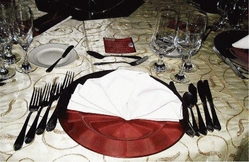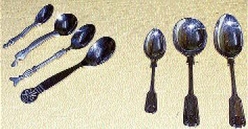
Do not be intimidated, start from outside in.
One of the social tragedies of this current era of faxes, emails, iPods, laptops and the technology age, is that there is no commensurate boom in the social or people skills necessary to complement wider interaction among people. Consequently, while there is seemingly more communication across the board at all and every level, there has been a decline in interpersonal skills, especially of social etiquette.
As a result of this decline, today, we have on paper (in some cases) a far better educated society, a far more aware community, an even more vocal population, but sadly a society growing more distant by the moment.
Sadly, for most of the young who inhabit the virtual world, from time to time both worlds interface. In the real world where people actually meet and greet one another for dinner and other social interaction, a rudimentary understanding of the social graces is a necessity.
More than a grasp

A set of the right spoon for all occasions is always most helpful in the kitchen. This set of modern-living spoons contains: (set of four from left) jam spoon, tea spoon, sugar ladle and an expresso spoon. At right are a tablespoon, soup spoon and teaspoon. - File photos
And whereas some of the up-and-coming 'wing it', with a basic understanding of these graces and get access to the table, staying there has proven that it does require more than just a grasp of things.
The world is replete with actual stories of con artists who were able to pull off some of the greatest confidence tricks, simply because they knew how to say and do the right thing. In short, their ability to speak the language and walk the talk got them through the door. Equally true, many dreams are left unfulfilled because those in pursuit of them, accoutred themselves well with the requisite educational qualifications, but neglected to school themselves in the art of the social graces.
Socially insecure
Many invitations go begging for a reply, primarily because the invitees are socially insecure, and out of fear of being seen to be doing the 'wrong' thing at the dining table, simply ignore that all-important invitation and all the possibilities it represents.
This fear comes from not knowing the protocol governing the use of stemware and not knowing the correct use of silverware! And rather than aggressively pursue the knowledge to make them better able to function, they gloss their ignorance over in the hope that they will be able to wing it.
This week we will deal with the troublesome area of silverware.
If you grew up in a household where dining etiquette was not a premium, the experience can be a daunting one. And especially so if that maiden voyage is at a formal dinner.
While most people have some kind of exposure to dining out, the rise of the buffet experience has robbed them of the intimate introduction to the use and knowledge and/or identification of silverware. Buffets reduce the dining experience to the basic knife and fork and or maybe the inclusion of the soup spoon. And so, sadly, in this the era of buffets and fast food, the fundamentals of dining etiquette have taken a back seat.
So, let us begin by identifying items of silverware likely to be in your place setting at a formal dinner party:
Dinner fork is usually the largest one at a place setting.
Salad fork has an extra thick prong on the far left. (Can be used in cutting lettuce, etc).
Fish fork is the smallest fork that is set to the left side of the plate.
Oyster fork, the smallest fork, is the only one that is supposed to be placed on the right side after the knives, next to the soup spoon. It is very thin with three prongs.
Dinner knife is usually the largest one at a place setting.
Salad knife is shorter than the dinner knife, with a rounded blade.
Fish knife is often mistaken for a butter knife by the novice but is easily distinguished by its almost medieval sword -like appearance or its placing in the pecking order.
Steak knife is sharper than the dinner knife and it usually has a jagged edge.
Soup spoon is the largest spoon at the table.
Dessert spoon and knife petite versions of the soup spoon and dinner fork.
Place setting
Now, it is important to point out that place setting may differ from one culture to another, but by and large, your place setting should consist of place plate in centre (napkin on top or to the left); to its right the knives and soup spoon. The soup spoon being far most right as it is the first piece of silverware you utilise. To the left of the soup spoon is your salad knife. Left of the salad is your fish knife, and closest to the place plate is your meat knife. But that is all if your are dining continental and not American, as while the American setting will see the salad knife set as the second piece of silverware from the right, to facilitate the salad that comes before the main course, in the continental setting, where the salad comes after the main course, the salad knife is then placed to the left of the meat knife, and is the innermost piece of silverware to the right of the place plate.
Correspondingly, on the left of the place-plate, the setting will see salad fork, on the outer left moving to the right, followed by your fish fork and next to the innermost side of the place plate, the meat fork. Remember that, if the dining is American or continental, then you might end up with the salad fork as the innermost piece of silverware.
At the top of the place plate, you will find your dessert spoon and fork, and as their names suggest, these two pieces of silverware are the last two pieces to be utilised.
The more formal the setting, the less likely you will find a teaspoon in your line-up of silverware as when tea or coffee is served at the end of the meal, the server will present you with your tea/coffee cup, if still at the dining table, will be served in demitasse, the spoon placed on the saucer, to the right of the handle of your cup.
At the dining table, the first thing you do when shown to your seat at the dining table is to remove the napkin from in front of you, open into a rectangle or triangle, and place onto your lap.
REMEMBER
1 Never use the napkin as a handkerchief to mop a sweaty brow, or as a tissue to dab at lipstick during dinner.
For most people, the first item of silverware utilised is the butter knife, which is usually placed on top of the bread and butter plate, which is to the left of the place plate and above the forks.
If you decide on helping yourself to some roll(s), remember to place the butter on the plate before you actually butter your roll(s).
2 Remember to always break your roll into bite-size pieces before eating, as you should never have half-bitten or chewed-through bread on your side plate. And please, however tempting, forgo the craving to make a bread and butter sandwich.
3 If you must leave the dining table during the meal, say a quiet excuse to the people on either side of you, leaving your napkin on your chair, not the table, as you leave and push the chair back under the table until you return.
4 After taking your seat and placing your napkin, familiarise yourself with your place setting, and everything else in front of you - salt and pepper, salad dressing, rolls, butter, cream, etc, as this will make it easier for you to function during dinner, as it is important to remember that apart from you needing to know for your own comfort, from time to time you will be required by fellow guests to pass the salt, etc, and knowing the lay of the land, makes this a smooth operation for all involved.
5 Remember in passing, to pass to the right; never help yourself first, but wait until the particular item has gone around the table and made its way back to you before it's your turn. If passing something with a handle, always pass it with the handle facing the other person, so they can take hold of it easily.
6 Remember when eating your soup, you spoon it away from you and then up to your mouth, eating from the side of the spoon. Never blow into your soup to cool it, or worse, add an ice cube for the same purpose.
7 If your soup is really good and you want it all, it's okay to slightly tilt the soup bowl away from you to get the last morsels in the bowl. When finished, place the spoon in the plate beneath the bowl. If no plate were provided, then leave the spoon in the soup bowl.
8 If your salad is not served with bite-sized pieces, do so before you start eating it.
9 Always remember that the dining experience was never intended to be anything but equal to that of a marathon, as against that of the one hundred-metre dash. In this respect, pace yourself, so you are in concert with fellow diners.
10 Never point or make gestures with your silverware.
11 Never attempt talk with a full mouth.
12 Avoid the tendency to slice up everything on your plate at the beginning then place your knife to the side of the plate, then only use the fork during the course of the meal. The knife and fork work in tandem with each other.
13 If during the course of dinner, you must remove something from your mouth, take it out, the same way it went in. That is, if you used a fork to bring it to your mouth, use the fork to remove it. If it were finger food and you used your hand, and then use your hand to remove it. Remembering never to try and hide it in the napkin, or under the plate, but to place it on to the side of your plate, or side plate.
14 At the conclusion of the dining experience, remember to 'close' your knife and fork, by placing them anywhere between the 4:20-5:20 p.m. positions.
15 Never push your plate away or stack them on each other in your desire to help with the clearing up, as this is considered rude. And for heaven sake, do not volunteer to help take them into the kitchen.
16 In your final act at the dining table, place your loosely folded napkin on the table, just as you stand to leave, not before.
Remember, practice makes perfect, so try this at home before going abroad to. And remember, the dining-out experience is supposed to be one of relaxed enjoyment, not a performance art, so relax and enjoy your role as a honoured guests, as after all, of all the people your hosts could have invited to share their company and break bread with them, they choose you, and that makes you special!